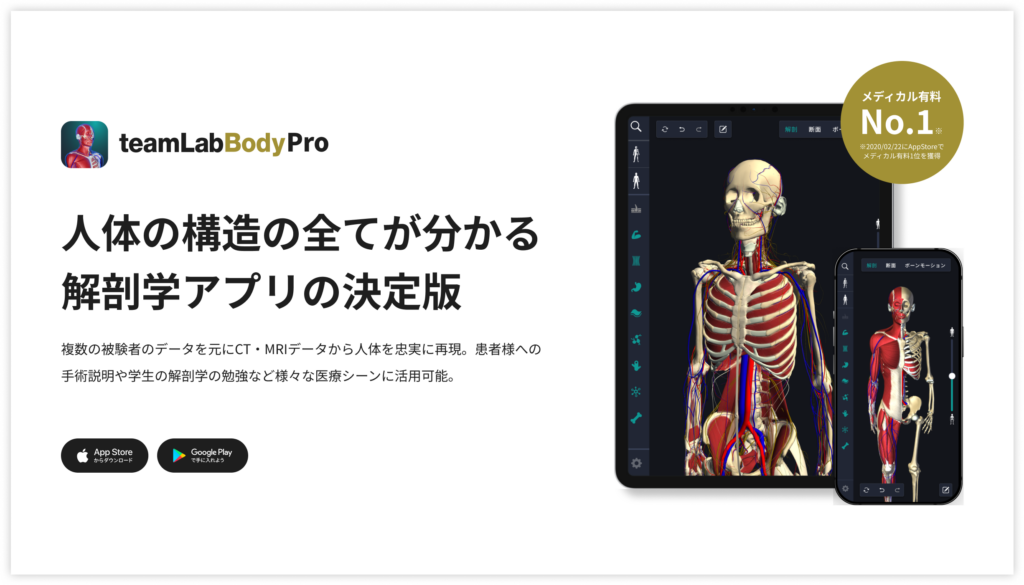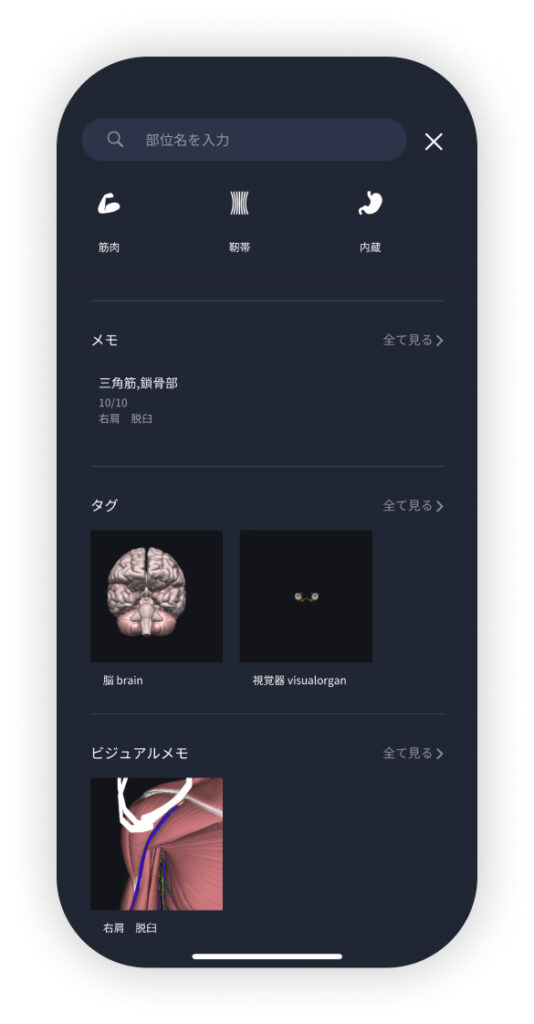beginning
In this article, I will explain effective study methods, starting with knowledge of specialized parts in human anatomy.
In human anatomy, it is necessary not only to memorize the names of various organs, muscles, and bones, but also to remember where they are located in the body. Therefore, it is necessary to learn as efficiently as possible.
I hope you will deepen your understanding even a little by reading this article and using the app.
Now, I'll explain the details about the “ring-shaped vocal cord” and how to study human anatomy.
teamLab Body Pro Free Download
A 3D anatomy app that shows all the structures of the human body
Download teamLab Body Pro here!

What is the ring-shaped vocal cord?
The anatomy application allows you to view a selection of anatomy 3D models. In this model, there are various observation methods such as surfaces, cross-sections, and nervous systems. This time, I'll explain using an anatomy application.
About the ring-shaped vocal cord

The cricovocal membrane (cricovocal membrane) is an elastic fibrous membrane that extends upward from the upper edge of the cricoid cartilage, and exists to reinforce the lower part of the vocal cord ligament. This membrane is one of the elements constituting the subglottic membrane (conus elasticus), which is part of the membranous structure of the larynx, and connects cricoid cartilage to vocal ligaments, especially the inner part thereof.
It plays a role as a foundation that supports the stability of the glottis and proper vibration of the vocal cords, and it can be said that it is of high structural importance. When this membrane hardens due to inflammation or post-traumatic scarring, it may cause subglottic stenosis and dysphonia. The ring-shaped vocal cord membrane is an anatomical element that contributes to vocal function as an elastic support structure for the larynx while adjoining the ring-shaped thyroid gland.
Study points
Anatomical understanding: structure and location of the ring-shaped vocal cord
When learning about the ring-shaped vocal cord, it is important to first understand the overall picture of the subglottic membrane (conus elasticus), which is its parent body. The subglottic membrane stretches upward from the inner surface of the cricoid cartilage and is continuous downward from the left and right vocal ligaments. Of these, the upper structure connecting to vocal ligaments is equivalent to the annular vocal cord membrane. It is sometimes omitted in standard diagrams of anatomy, but it is effective to learn while visually confirming the positional relationship between cricoid cartilage and vocal cords by using a sagittal diagram of the larynx or a 3D application. Also, since it is easy to confuse it with the ring-shaped thyroid gland, which has a similar name, it is important to distinguish and memorize each position and structure.
Functional understanding: relationship with vocalization mechanisms
The ring-shaped vocal cord membrane reinforces the lower part of the vocal cord ligaments and plays a role in stabilizing vocal cord vibrations during speech. Due to the movement of the cricoid thyroid joint, when the thyroid cartilage tilts forward, the vocal ligaments are stretched, and the pitch of the voice changes. Along with this movement, the ring-shaped vocal cord also adjusts tension in conjunction with this movement, so it is indirectly involved in pitch adjustment of speech. By lightly touching your larynx and changing the pitch of your voice, you can learn while experiencing structural movements and muscle coordination.
Practical application: relationship with subglottic stenosis and airway maintenance
The ring-shaped vocal cord membrane is a clinically important structure from the viewpoint of vocalization and airway security. Fibrosis of this membrane after inflammation or trauma can reduce vocal cord mobility, leading to subglottic stenosis and speech impairment. Children in particular have narrow airways, so be careful as even minor disorders can cause breathing difficulties. Also, in procedures to secure the airway, there is also a risk of mistakenly puncturing this membrane by confusing it with an annular thyroid membrane, so accurate position grasping is required. Through training using cross-sectional anatomical images and laryngeal models, it is possible to develop safe and accurate response skills.
How to study human anatomy
I will explain specific study methods using human anatomy applications.
Check your past learning history and practice repeatedly
Here are the steps to check your anatomy learning history and practice iteratively effectively.
1. Check your learning history in the app
Reviewing your learning history with the application is an important step in effectively advancing anatomy learning. First, launch the app and go to the learning history section from the main menu. Many anatomy apps are designed to show your progress in the form of graphs and lists, so you can visually check which parts you've learned about and how much time you've spent.
By using this data, you can understand which areas you have strengths in and where you need to spend more time and effort. We also recommend using a dedicated tag or notebook function to mark areas you are particularly weak at or where you need to relearn. Regularly checking your learning history and looking back on past learning content will lead to efficient review and deepening understanding.
2.Make a plan for iterative learning
Making an efficient repetitive learning plan based on learning history is extremely effective in promoting knowledge retention. First, identify weak points and areas where you need to relearn. Next, arrange these study items into a weekly or monthly calendar and create a specific study schedule. By proceeding in a planned manner, you can learn each part evenly and avoid packing in a large amount of information at once.
Using a task management app or digital calendar to set study reminders is effective. Also, it's important to have the flexibility to regularly review progress and revise plans as needed. By having goals and proceeding with your studies in a planned manner, you can efficiently acquire anatomical knowledge.
3.Use 3D features to learn visually
By utilizing the 3D function, learning anatomy is easier to understand visually. The 3D model shows the structure of the human body three-dimensionally, and each part can be observed in detail. This makes it possible to intuitively grasp positional relationships between deep muscles and organs that are difficult to capture in a planar view. For example, you can learn even the smallest details by rotating specific muscles and bones and zooming in and out.
Also, there are many apps that have the function of displaying cross-sectional views of each part using a 3D model, which is useful for deepening understanding of internal structures. This diversity of visual information helps with memory retention and improves immediate responsiveness in tests and practice situations. By utilizing the 3D function and learning visually, you can learn anatomy knowledge more deeply and efficiently.
Use the memo function concretely

Make notes so you don't forget the things and points you've noticed while studying. The memo function can be used for different purposes, such as inputting text, saving images, and writing memos. Tag your notes to make them easier to review later.
Test your learning regularly in the form of quizzes
Regularly testing what you've learned in a quiz format is a very effective way to anchor your anatomy knowledge. Quiz-style tests help you objectively grasp your level of understanding and areas you lack while repeating knowledge.
For example, by using a learning app to conduct quizzes every specific period, you can reconfirm what you've learned and strengthen your memory. There are a wide range of quiz formats, such as multiple choice questions, fill-in-the-blank questions, and short answer questions, and each helps understanding from a different angle and develops the ability to utilize various types of knowledge.
Get feedback
If possible, get feedback from other learners and experts. It helps you find your own gaps in understanding and areas for improvement. You can also keep yourself motivated to learn by regularly testing yourself. Feeling a sense of accomplishment and progress increases motivation for continuous learning.
summary
This time, I explained how to study the “ring-shaped vocal cord” using an application!
Thank you for reading this far.
I would be happy if reading this article helped you learn about anatomy.
Learning is a long, never-ending journey, but I sincerely wish you all the best. Let's continue to study together and work hard for the national exam!
Please look forward to the next blog.
teamLab Body Pro Free Download
A 3D anatomy app that shows all the structures of the human body
Download teamLab Body Pro here!





